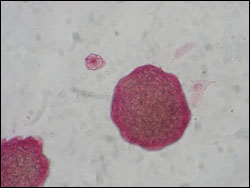UCSD Discovery Shows How Embryonic Stem Cells Perform ’Quality Control’ Inspections

Photo of mouse embryonic stem cells Credit: Tongxiang Lin, UCSD
Biologists at the University of California, San Diego have found a fundamental mechanism used by embryonic stem cells to assure that genetically damaged stem cells do not divide and pass along the damage to daughter stem cells.
Their discovery, detailed in an advance online publication of the journal Nature Cell Biology, solves the longstanding mystery of how embryonic stem cells, which have the potential to divide an unlimited number of times and differentiate to make all of the cell types in the body, are able to avoid duplicating cells that have sustained genetic damage.
“What we discovered is a primary mechanism that allows embryonic stem cells to perform quality control inspections during their self-renewal, the process by which these cells undergo unlimited cellular division to produce an unlimited number of daughter cells,” says Yang Xu, an associate professor of biology at UCSD who headed the research team.
“Since DNA damage can occur during normal cellular propagation as well as after the exposure of cells to DNA-damaging radiation and chemicals, it is critical for the embryonic stem cells to develop stringent mechanisms to ensure the repair of DNA damage and prevent the passage of DNA damage to their daughter cells. Unrepaired DNA damage will cause genetic instability and, ultimately, cellular transformation into cancer cells.”
Xu and his team made their discovery while working with embryonic stem cell lines from mice, which possess the same known properties and capabilities as human embryonic stem cells. They found that a protein, p53, known to play a critical role in the suppression of tumors in both humans and mice, is also used to maintain the genetic stability of embryonic stem cells.
The scientists, who included Tongxiang Lin, a UCSD postdoctoral fellow and the first author of the study, and Connie Chao, a graduate student in Xu’s laboratory, discovered that p53 activated by DNA damage in mouse embryonic stem cells directly suppresses the expression of a gene called Nanog, which is necessary for the self renewal, or unlimited duplication, of these stem cells. The suppression of Nanog promotes embryonic stem cells to differentiate into other cell types.
“The end result of all of these actions by p53 is to deprive embryonic stem cells with DNA damage the ability to self renew themselves and pass the DNA damage onto their daughter cells,” says Xu. “p53 also contributes to the eventual elimination of DNA damage in the embryonic stem cells that have already differentiated into specific cell types, thus preventing the development of cancerous cells.”
“These findings will open new avenues of research for those of us who study mouse embryonic stem cells on how these cells maintain genetic stability and self renewal,” he adds. “They will also provide a foundation for future studies involving human embryonic stem cells of how these cells maintain genetic stability during their self renewal.”
Other scientists involved in the study included Shin’ichi Saito, Sharlyn Mazur and Ettore Appella of the National Cancer Institute in Bethesda, Md., and Maureen Murphy of the Fox Chase Cancer Center in Philadelphia. The study was supported by a grant from the National Cancer Institute.
Media Contact
More Information:
http://www.ucsd.eduAll latest news from the category: Life Sciences and Chemistry
Articles and reports from the Life Sciences and chemistry area deal with applied and basic research into modern biology, chemistry and human medicine.
Valuable information can be found on a range of life sciences fields including bacteriology, biochemistry, bionics, bioinformatics, biophysics, biotechnology, genetics, geobotany, human biology, marine biology, microbiology, molecular biology, cellular biology, zoology, bioinorganic chemistry, microchemistry and environmental chemistry.
Newest articles

Bringing bio-inspired robots to life
Nebraska researcher Eric Markvicka gets NSF CAREER Award to pursue manufacture of novel materials for soft robotics and stretchable electronics. Engineers are increasingly eager to develop robots that mimic the…

Bella moths use poison to attract mates
Scientists are closer to finding out how. Pyrrolizidine alkaloids are as bitter and toxic as they are hard to pronounce. They’re produced by several different types of plants and are…

AI tool creates ‘synthetic’ images of cells
…for enhanced microscopy analysis. Observing individual cells through microscopes can reveal a range of important cell biological phenomena that frequently play a role in human diseases, but the process of…





















